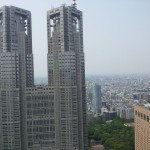The past two days I attended the Tonomura FIRST International Symposium on “Electron Microscopy and Gauge Fields”, in honor of Akira Tonomura and his efforts in realizing a 1.2 MV electron microscope. Tonomura was the person to first conclusively confirm the Aharonov-Bohm effect, which is one of the wonders of quantum mechanics and one reason why students fall in love with physics (more below).
Incredibly sadly, Tonomura was diagnosed with pancreatic cancer one year ago, seemed to recover well from a major operation, but passed away exactly one week before the symposium. It was supposed to be a grand meeting of his scientific friends, but rather turned into a memorial conference. It was impressive nonetheless, located at the top floor of the Keio hotel with talks by amongst others Yakir Aharonov and Nobel Prize laureats C.N. Yang, Tony Leggett and Makoto Kobayashi. I realized only Wednesday morning that I actually read one of his books, I even cited it in my Master’s thesis.
I particularly liked Aharonov’s talk, in which he explained how he came up with the prediction for the AB-effect. This phenomenon is a variation on the quantum version of Young’s double-slit experiment, which is typically used to verify the wave nature of fields and particles. Here is a cute video portraying the single-electron double-slit experiment. Aharonov and Bohm suggested putting an infinitely thin solenoid right between the slits, so that there is a magnetic field between the trajectories but not on any trajectory the electron can take. In electrodynamics a magnetic field curves the motion of a charged particle (such as an electron), this is called the Lorentz force, but only when the particle actually travels through regions of non-zero magnetic field. AB predict that the interference pattern is shifted from its central position, due to the presence of a magnetic field in between, even though the electron never ‘feels’ the magnetic field directly.
In solid state physics, the periodic nature of the atoms or ions in a crystal lattice causes so-called bandgaps in the energy spectrum, which is why some materials are electric insulators and some are metals. The reason behind this is called Bloch’s theorem; so, potentials periodic in space cause gaps in energy. Aharonov told how, as a graduate student, he though about generalizing this to potentials periodic in time, which should analogously lead to gaps in momentum. This was the initial step to the AB effect, which at the time caused a lot of fuss, with some eminent physicists not willing to accept it.
The mechanism behind the AB effect is by now well established and well understood, but it has deep implications for the inherent non-local nature of quantum mechanics. Aharonov proceeded by converting the standard way of looking into the so-called Heisenberg picture, which he claimed identifies much more clearly the non-locality issue. This was very interesting and I’d have to look into this more carefully, perhaps by reading this article or his book.
The second day was devoted to the electron microscopy itself. What people basically do is shoot a beam of electrons at a target sample, and detect the beam a little bit further on. So you’re basically looking at the ‘shadow of the electron beam’, but like with lasers you can also probe phase and coherence properties being altered by the interaction with the sample. The higher the energy you can put in the electron beam, the higher your resolution will be, and by now one can look at individual atoms. There’s a nice explanation on the project’s website itself. On this day I especially enjoyed the talk by David Smith step-by-step outlining the current limits of the machines, and indicating where improvements can be made.
The current project which was initiated and supervised by Tonomura, aims to build a 1.2 MV electron microscope, making it the most powerful in the world. It is expected to be operational next year. It was funded by of the FIRST program, which is basically a part of the money the government assigned to stimulate the economy after the final crisis of 2008. My own group is also funded by this program.


Recent Comments